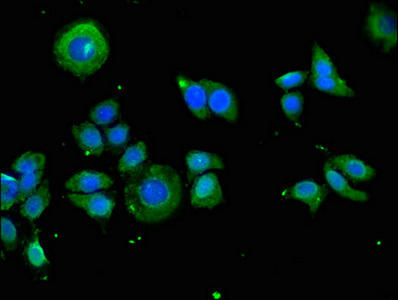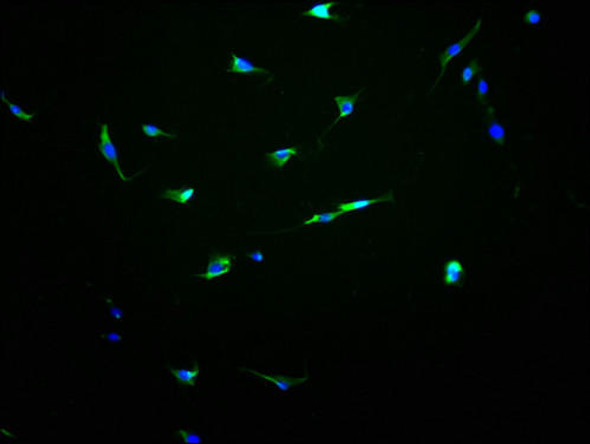Description
| Antibody Name: | KIR2DS3 Antibody (PACO50482) |
| Antibody SKU: | PACO50482 |
| Size: | 50ug |
| Host Species: | Rabbit |
| Tested Applications: | ELISA, IF |
| Recommended Dilutions: | ELISA:1:2000-1:10000, IF:1:50-1:200 |
| Species Reactivity: | Human |
| Immunogen: | Recombinant Human Killer cell immunoglobulin-like receptor 2DS3 protein (102-241AA) |
| Form: | Liquid |
| Storage Buffer: | Preservative: 0.03% Proclin 300 Constituents: 50% Glycerol, 0.01M PBS, pH 7.4 |
| Purification Method: | >95%, Protein G purified |
| Clonality: | Polyclonal |
| Isotype: | IgG |
| Conjugate: | Non-conjugated |
 | Immunofluorescent analysis of PC-3 cells using PACO50482 at dilution of 1:100 and Alexa Fluor 488-congugated AffiniPure Goat Anti-Rabbit IgG(H+L). |
| Background: | Receptor on natural killer (NK) cells for HLA-C alleles. Does not inhibit the activity of NK cells. |
| Synonyms: | Killer cell immunoglobulin-like receptor 2DS3 (MHC class I NK cell receptor) (Natural killer-associated transcript 7) (NKAT-7), KIR2DS3, NKAT7 |
| UniProt Protein Function: | KIR2DS3: Receptor on natural killer (NK) cells for HLA-C alleles. Does not inhibit the activity of NK cells. Belongs to the immunoglobulin superfamily.Protein type: Membrane protein, integralChromosomal Location of Human Ortholog: 19q13.4Cellular Component: integral to plasma membraneBiological Process: cellular defense response |
| UniProt Protein Details: | |
| NCBI Summary: | Killer cell immunoglobulin-like receptors (KIRs) are transmembrane glycoproteins expressed by natural killer cells and subsets of T cells. The KIR genes are polymorphic and highly homologous and they are found in a cluster on chromosome 19q13.4 within the 1 Mb leukocyte receptor complex (LRC). The gene content of the KIR gene cluster varies among haplotypes, although several "framework" genes are found in all haplotypes (KIR3DL3, KIR3DP1, KIR3DL4, KIR3DL2). The KIR proteins are classified by the number of extracellular immunoglobulin domains (2D or 3D) and by whether they have a long (L) or short (S) cytoplasmic domain. KIR proteins with the long cytoplasmic domain transduce inhibitory signals upon ligand binding via an immune tyrosine-based inhibitory motif (ITIM), while KIR proteins with the short cytoplasmic domain lack the ITIM motif and instead associate with the TYRO protein tyrosine kinase binding protein to transduce activating signals. The ligands for several KIR proteins are subsets of HLA class I molecules; thus, KIR proteins are thought to play an important role in regulation of the immune response. [provided by RefSeq, Jul 2008] |
| UniProt Code: | Q14952 |
| NCBI GenInfo Identifier: | 6912474 |
| NCBI Gene ID: | 3808 |
| NCBI Accession: | NP_036445.1 |
| UniProt Secondary Accession: | Q14952,O00644 |
| UniProt Related Accession: | Q14952 |
| Molecular Weight: | 26.7 kDa |
| NCBI Full Name: | killer cell immunoglobulin-like receptor 2DS3 |
| NCBI Synonym Full Names: | killer cell immunoglobulin-like receptor, two domains, short cytoplasmic tail, 3 |
| NCBI Official Symbol: | KIR2DS3 |
| NCBI Official Synonym Symbols: | NKAT7 |
| NCBI Protein Information: | killer cell immunoglobulin-like receptor 2DS3; NKAT-7; MHC class I NK cell receptor; natural killer-associated transcript 7; natural killer cell inhibitory receptor |
| UniProt Protein Name: | Killer cell immunoglobulin-like receptor 2DS3 |
| UniProt Synonym Protein Names: | MHC class I NK cell receptor; Natural killer-associated transcript 7; NKAT-7 |
| Protein Family: | Killer cell immunoglobulin-like receptor |
| UniProt Gene Name: | KIR2DS3 |
| UniProt Entry Name: | KI2S3_HUMAN |






